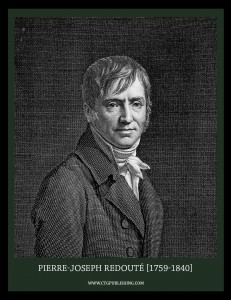Pierre-Joseph Redoute Biography
DIED: 1840, Paris
KNOWN AS: the Raphael of flowers
FATHER Charles-Joseph Redouté b. 1715 d. 1776
MOTHER Marguerite-Joseph Châlon m. 1850
BROTHER Antoine-Ferdinand Redouté b. 1756 d. 1809
BROTHER Henri-Joseph Redouté b. 1766 d. 1852
SISTERS Two with names unknown
WIFE Marie-Marthe Gobert m. 1786
DAUGHTER Marie-Joseph (Joséphine) b. 1786
DAUGHTER Daughter Marie-Louise (Adélaïde) 1792
SON Charles b. 1798
When Pierre-Joseph was a child, his father Charles-Joseph, taught him to paint. At the age of 6, he was creating small paintings. At the age of 13, he left home and traveled to Flanders and Holland. For a year, he lived in Vilvorde. He earned a living by painting doors, decorating houses and creating canvases for churches. He returned home in about 1776 because of his father’s illness. His father died that same year.
After his father’s death, Pierre-Joseph returned to his travels settling in Heylissem (Hélécine) as a painter for the church. He then returned home and was commissioned to paint portraits for General Bender and Doctor Embinet. He also gained the admiration of Princess de Tornaco who sent him to Paris with letters of introduction.
In 1782, Pierre-Joseph joined his brother, Antoine-Ferdinand, in Paris who had lived there since 1776. Although he attempted decorative arts as a profession, the branch of arts which his brother excelled in, Pierre-Joseph soon found himself drawn to the illustration of flowers.
In 1784, he created some prints for M. Chereau, a print merchant. These prints were viewed C. L. L’Heritier who was struck by his talent. He followed L’Heritier to London (Kew) and provided some of the plates for his Sertum Anglicum. In all, he created over 500 drawing for L’Heritier.
During this same period, Pierre-Joseph also found work with Gérard van Spaendonck, who commissioned him to create 20 drawings. He served as a botanical painter for both Queen Marie Antoinette who was also, according to Gordon Rowley, his student. Also according to Rowley, Redouté, while working for Marie Antoinette, was summoned at midnight to paint her favorite night-blooming Cereus [possibly Selenicereus grandiflorus] in front of the royal court.
In 1792, with the fall of the monarch, he found employment with the physics and mathematics division of the academy of sciences.
On September 2, 1793, the Museum of Natural History held a competition to select artists for the museum. Pierre-Joseph, his bother Henri-Joseph and another artist Maréchal won the competition.
Although Pierre-Joseph created many works in black and white, he is most famous for his color prints including Les Liliacees (1802-16) which was funded by another student and supporter, Empress Josephine to whom he became the official flower painter in 1805.
According to Rowley, Empress Josephine funded many of Redouté’s works including Les Liliacees (1802-16), Jardin de la Malmaison (1803-05), Descriptions des Plantes Rares Cultivees a Malmaison (1812-17) and Les Roses (1817-24).
He also created many plates for Plantes Grasses [Plantarum Succulentarum Historia] (1799-1837) which was a serial work published over several periods, interrupted because of a falling out between A. P. De Candolle and the publisher. The number of plates produced in this series is unknown but may be as many as 192, according to Rowley. This work also incorporated his new color printing technique although he may have employed it as early as his plates for L’histoire des champignons.
In 1819, his works were exhibited at the Louvre. In 1822, he and Nicolas Huet were appointed for the iconography courses at the Museum of Natural History. His first class was taught on the 15th of April, 1824 to 150 students, both male and female.
On January 14, 1825, King Charles X honored Pierre-Joseph as a chevalier de la Légion d’honneur. He had many royal students including Marie-Antoinette, Josephine, Adélaïde of Orléans and Marie-Louise.
In 1834, he was name to the Ordre de Léopold of Belgium. In 1836, he published Choix de soixante roses and dedicated the work to his student, Louise of Orléans, the Queen of Belgium. He died in Paris in 1840.
Sources:
Plantarum historia succulentarum (Gordon Rowley)
Histoire et description du Muséum Royal d’histoire naturelle (1823, Joseph Philippe François Deleuze)
Biographie liégeoise (Antoine Gabriel de Becdelièvre-Hamal, 1827)
Dictionary of Painters and Engravers (Michael Bryan, 1889)

